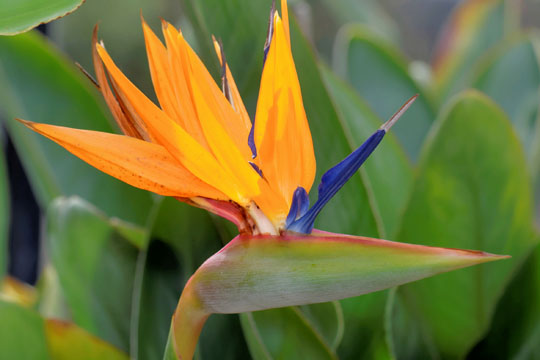Plant structures inspire cool concepts
Freiburg bionics specialists develop trouble-free, bioinspired shades for building facades
Leaves form the jaws of a trap: the mechanism that the carnivorous waterwheel plant uses to catch its prey inspired Freiburg researchers to incorporate and develop it into a design for bionic shades for building facades. Photo: Plant Biomechanics Group
Palatial glass structures dominate the architecture in many modern cities. Large windows let the sun shine in and create light and airy spaces. But with sunlight comes heat. "Air conditioning buildings consumes an enormous amount of energy," says Dr. Simon Poppinga, a biologist. That's why a wide variety of shades and blinds are used to keep the heat out. Yet Dr. Thomas Speck, a professor and head of the Plant Biomechanics Group at the Botanical Gardens of the University of Freiburg says, "Conventional shades for facades break easily." Speck and Poppinga are bionics specialists. They see concepts in the structures of living things and use them to develop technical solutions – such as bionic, kinetic shades for building facades. These are less delicate and easier to maintain than conventional shades. What is more, they are perfectly suitable for curved structures.
Weaver birds' weight opens blooms
The initial idea came from the South African bird-of-paradise plant, also known as "Strelitzia reginae." Two petals of the flowers form a small, boat-like shape, in which pollen and, at the base, sweet nectar, collect. The nectar attracts the weaver birds. "In order to reach the nectar, the birds land on the petals of the bloom. Their weight causes the petals to fold out to the side,” says Poppinga. The bloom opens, clearing the way to the nectar. As the birds eat, the pollen sticks to their feet and is carried to the next flower, pollinating it. Poppinga is also a group leader. While working on his doctorate, he discovered that every petal is composed of reinforced ribs connected by thin membranes. The ribs bend under the weight of the bird and the membranes automatically open. Bionics specialists extrapolate their designs from nature, emphasizes Poppinga, "We didn't make one-to-one models of the petals."

The flowers of the bird-of-paradise plant provided the inspiration for Flectofin, the first bionic shade developed by biologists at the University of Freiburg. Photo: JuergenL/Fotolia
"Hingeless" shades
Conventional shades are made of inflexible elements, often something such as horizontal slats connected to each other with joints. "There are plenty of hinges that easily jam," Poppinga says. The slats can twist and tear, he continues. Flectofin bionic building shades don't have these faults. They feature a number of sections – like bird-of-paradise petals – that stand next to each other. Membranes are located on both of their surfaces, and, in principle, they work like slats. They fold into the spaces between the sections to block the light. The shades close when the sections are bent hydraulically, the way the weaver bird's weight does on Strelitzia's flowers. "The mechanism is reversible, because the sections and membranes are flexible," says Poppinga. If the pressure on the sections is released, light again floods the rooms.
A functional, reliable principle
One of the obvious advantages of Flectofin over conventional slats is that the vertical membranes stay cleaner because dirt does not collect in them. Plus, flexible sections and membranes are more durable than stiff materials and controlling them is simpler. There aren't any joints or hinges. "The principle is functional and reliable," says Speck. Nevertheless, Poppinga and Speck weren't completely satisfied with what Flectofin could do. "The closing mechanism required a relatively great deal of force," explains Speck. So two new actors came into play: The waterwheel plant ("Aldrovanda"), which is carnivorous and grows under water; and biologist Anna Westermeier, who is writing her doctoral thesis on "Aldrovanda's" family, "Droseraceae." Her job was to reveal the plant's secrets. "The plant is the real sensation," she says.

The waterwheel plant's name comes from the leaves that resemble the spokes of a wheel.
Photo: Plant Biomechanics Group
Secret of speedy, snap trap closure revealed
The waterwheel plant is something like a submarine Venus flytrap. "Both have traps that close very quickly," says Westermeier. "But waterwheel plants' traps are much smaller. They're only three millimeters tall," she adds. That's more than enough space to catch water fleas and consume them. The waterwheel plant is extremely difficult to cultivate – and the jaws of its trap close at the slightest touch. That led Westermeier to set up a special experimental model of the sensitive plant. "After that we could make 3-D images of its closing mechanism under controlled conditions," explains the biologist. The test set up needed was so big it filled a room, but it allowed all the details of the plant's trapping mechanism to be observed. Waterwheel plants are made of a single leaf and a sensitive hair, or cilia. As soon as a flea touches the cilia, the insect is doomed. The central rib of the leaf bends slightly downwards and the sides of the leaf fold, closing the trap with the flea inside.

The new, Flectofold facade shades are easier to fit to curved surfaces than its predecessor, Flectofin.
Photo: ITKE & ITFT
More elegant and easier to shape than its predecessor
"Surprisingly little force is required to produce such a large movement," says Speck. The trap closes quickly and uniformly. The modification of the function principle led to the bionic facade shade Flectofold. Speck says that prototypes have already been built and are "in the final testing stage." Flectofold has a several advantages over its predecessor. The material and durability extend service life and improve its environmental balance. The shade is more elegant and can be shaped freely. "It's even easier to fit to curved surfaces," says a pleased Speck, whose working group at the Botanical Gardens is made up of 45 people. "I wish that many more bionic products would soon become available," says the bionics expert. "I want to transfer nature's beauty into product design."
Jürgen Schickinger


